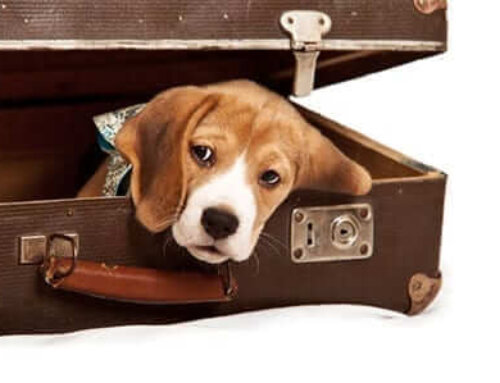My veterinary practice is in South Florida. Each year as the rainy season approaches I start getting calls from my clients asking for remedies and suggestions for thunderstorm phobia. Thunderstorms can be real ‘doozies’ in these parts, but just about anywhere there can be triggers to anxiety. Just this week I sent 3 “Thundershirts” out the door.
This article is focused on dogs as cats rarely get stressed out by storms or fireworks. Noise phobia and separation anxiety are the 2 most common causes of anxiety I see in my clinical practice. It’s more often a dog phenomenon. Perhaps this triggered the phrase cool cat! Whether your pet is diabetic or not, you may be faced with pet anxiety. Many pets (especially cats and small dogs) get anxious just going to the vet clinic!
Anxiety may present in a variety of manifestations, but destroying items in the home is very common. Some dogs will destroy drywall or chew up carpet, trying to escape a situation of being alone. Some pets will go potty inappropriately when left alone. Of course, we need to make sure the pet isn’t simply bored or have a urinary tract infection before we blame anxiety!
Let’s discuss simple “treatments” if a dog has anxiety, whether from storms or separation:
- Crating: Using a kennel isn’t just “dog jail”! When introducing a crate I like pet owners to leave the kennel door open initially. I encourage owners to give pets their toys or meals in the crate. We want a cage to be a positive experience. We want an anxious pet to view the kennel as a safe zone! Years ago when I adopted a dog who came from a bad situation she was initially very destructive. I put a kennel in the corner of my bedroom with the door wide open. When she was anxious she hid in the kennel. This lasted about a week until she realized life was good in the Sutton house. Her destructive behavior stopped quickly after I gave her a safe zone that was her own space. I never even closed the door to that kennel.
- Exercise: Exercise is the key to a happy pet. If you know a storm is coming or if your pet gets anxious each day when you leave for work, plan a good long walk beforehand. A pet just doesn’t get as anxious when it is tuckered out. A well behaved pet is a tired pet.
- Pheromones: Pheromones are very safe and can make a big difference for some dogs. DAP (dog appeasing pheromone) comes in a spray, an electric diffuser and in a dog collar. There are no known side effects. DAP is a synthetic pheromone that simulates the pheromone that nursing mother dogs naturally produce that calms newborn puppies. This is different from aromatherapy. I personally can’t detect any odor from DAP collars. I’ve used Feliway, a cat pheromone, for many years for cats who spray and for inter-cat aggression in multi-cat households.
- Thundershirts: one of my favorites during storm season. Afterall, we don’t know for sure when we leave for work if there will be a big storm, no matter the skills of our local weather forecaster. Thundershirts come in a variety of sizes. They are cloth vests with velcro closure to adjust the shirt to a nice snug fit. It’s much like swaddling a baby. Dogs feel like they are getting a big hug. I’ve had many clients swear by the Thundershirt.
- Desensitization: Desensitization to the cause of anxiety is key. If your pet goes has separation anxiety and goes berserk when left alone, often manifesting in destructive behavior shortly after your departure, you might wish to practice your departure clues (ie. getting your keys, putting on shoes, picking up your purse) without actually leaving. Then when you get home, wait until the pet has calmed down (appropriate calm behavior) before addressing (rewarding) your pet. If your pet reacts to strangers, gently and slowly bring folks into the home over a period of time. You get the idea.
Sometimes a pet has no anxiety at all except in acute situations. The Fourth of July with fireworks is the best example. If it is simply a rare event like annual fireworks, you might just consider staying at home with your pooch that night.
Now, what if you need chemical assistance? Afterall, we all have our limits to chewed up shoes or ruined carpet! We have medications that can help. Some anxiety meds are more suited for acute situations some more suited for chronic anxiety. Fluoxetine (the generic of Prozac) is probably my personal favorite for chronic anxiety in dogs, but Clomipramine is also FDA approved for canines. Vets have used many of the SSRI drugs for chronic anxiety in dogs. If the situation is acute in nature (visiting guests, travel, fireworks, thunderstorms) we may reach for Alprazolam (the generic of Xanax) or Trazadone. No matter the med, start at a low dose and sneak up on the minimally effective dose. If it is an acute situation, do a practice dose before the event. Write down how your pet reacted to that dose, so the next time you use it you remember how much to give.
Consult your veterinarian or veterinary behaviorist to see if your pet might benefit from pharmacologic intervention while you desensitize your pet. If you do use a medication in a chronic fashion and feel you’ve conquered your pets fears, be sure to taper off the drug over weeks before stopping the med. Never cold turkey behavior meds.
I’m always happy to have ADWDiabetes readers send me questions. It is where many of these newsletter ideas come from! Keep those questions coming to [email protected].
NOTE: Consult your veterinarian to confirm that my recommendations are applicable for the health needs of your pet.










Dr. Sutton
Could you please comment on anxiety in cats? We travel 80 miles with two cats, each in cages.
One of them is anxious and poops in cage up to 2 or 3 times. Also, she has occasionally vomited on the last curvy roads. If we go extra slow (usually not) and has been only in one car and not the other so probably more sway, bit poop is consistent in both. Any suggestions to prevent? All calming drugs from vet made her way too drowsy or strange we thought.
The other cat (a diabetic) does fine except for occasional vocals. Which brings to a second question: we use levemir after going thru other insulins that did not regulate him. To save we now use the pens as you recently mentioned. As I understood you suggested could use beyond the 42 days. We have been discarding for next pen when there is more left of course. Could you elaborate more? We keep at 4c and handle very carefully not touching injection site.
Thank you,
Theresa
Dear
Dr. Joi,
I have asked you questions before on my older minpin
that has a compounding of issues, including diabetes, cushings disease,
cataracts, and now nasal cancer. As “luck” would have it, my 11
year old minpin has just been diagnosed with diabetes. The issue is
“anxiety about receiving an insulin shot”. She runs, hides, and
when I encourage her lovingly, she yelps and flinches when I try to
“tent” her skin and it is a nightmare to give her the
injection. Any suggestions?
Thank you,
Cyndie